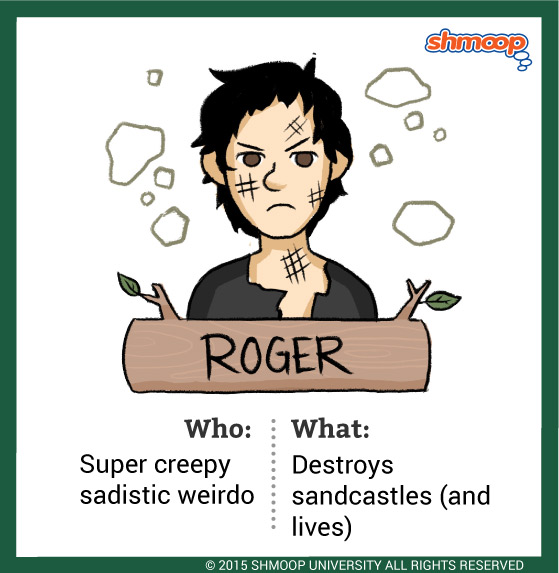Character Analysis

(Click the character infographic to download.)
Roger is totally that kid on the playground who used to torture ants with a magnifying glass. He's bad news going all the way back to when we first meet him, a "slight" and "furtive" boy with "an inner intensity of avoidance and secrecy" who "mutters" (1). Let's just say, you do not want to be stuck on a deserted island with Roger, because this guy is sadistic, plain and simple.
While Jack wants power because he likes the thought of being in charge, Roger wants power because he likes the idea of hurting others. Even before things have started to go too wrong, we can tell. He and his buddy Maurice destroy the littluns' sandcastles for no reason at all, "kicking them over, burying the flowers, scattering the chosen stones. Maurice followed, laughing, and added to the destruction" (4.7-8). This goes way beyond not helping the kids pick fruit to straight up psycho behavior.
Roger doesn't become a murderous psychopath all at once. At first, he's held back by the "taboo of the old life" (4.14). While he throws rocks in little Henry's general direction, he doesn't actually throw them at the kid: "round the squatting child was the protection of parents and school and policemen and the law" (4.14). For now. By the end, Roger has given in. He's the one who, with "delirious abandonment," drops the rock that kills Piggy.
Not convinced that Roger is bad news? Sam and Eric hint at unspeakable—literally—horrors, when they say: of Sam and Eric's exchange:
"You don't know Roger. He's a terror."
"And the chief—they're both—"
"—terrors—"
"—only Roger—" (11)
Only Roger what? We don't know, and we're not sure we want to. Is Golding saying that even beasts come in degrees—that some people are worse than others, even if we're all savages? Or is he saying the opposite? Could it be that Roger is actually the most human of them all?
Roger Timeline